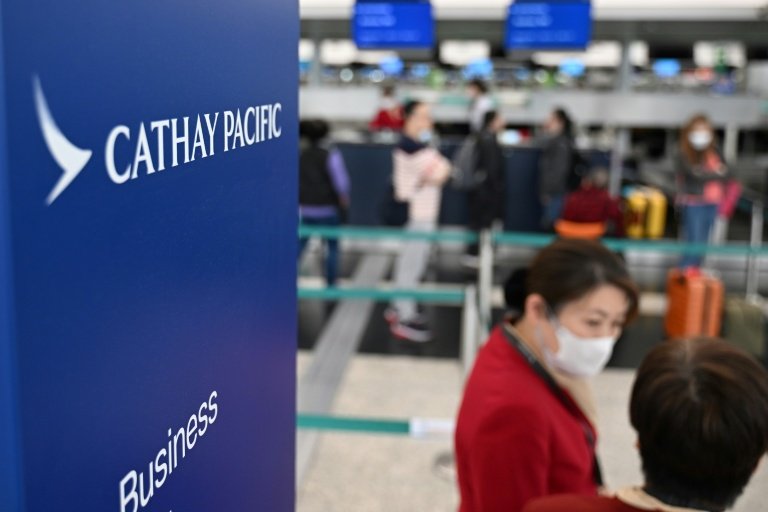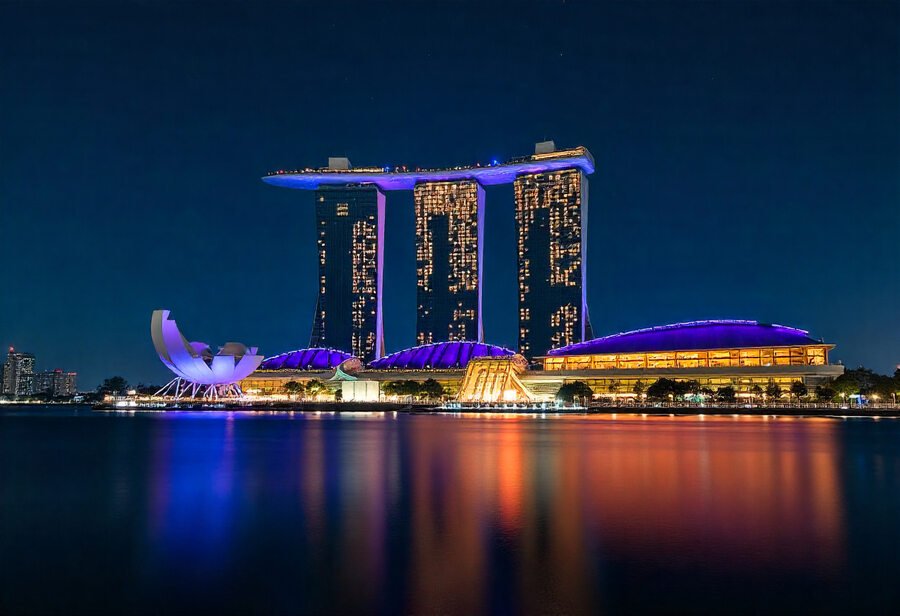Asia Travel Pulse
Hong Kong’s Cathay Pacific unveils deal to buy 14 Boeing jets

Cathay Pacific has benefited from a pick-up in travel demand in Asia – Copyright AFP Peter PARKS
Tommy WANG
Hong Kong’s Cathay Pacific said Wednesday it would place an US$8.1-billion order for 14 Boeing jets, its first with the US aircraft maker for more than a decade.
In a filing to the Hong Kong stock exchange, the airline said it would “purchase 14 Boeing 777-9 aircraft” and had “secured the right to acquire up to seven additional Boeing 777-9 aircraft”.
Cathay already has a fleet of more than 230 mostly passenger aircraft.
The new order expects the aircraft to be delivered by 2034, according to a separate filing.
Cathay was one of the first buyers to commit to Boeing’s 777X programme when it unveiled the purchase of 21 aircraft in 2013.
Boeing said in a statement the new deal brought the order book of 777-9 aircraft — “the world’s largest twin-engine airplane” — to 35.
The aircraft, designed to reduce fuel use and emissions, would meet Cathay’s growing global travel demand, Boeing added.
Hong Kong’s aviation sector was hit hard by Covid-era policies, which imposed strict rules on travellers that kept it internationally isolated before they were lifted in late 2022.
In 2024 Cathay’s attributable profit rose slightly to US$1.27 billion, however, and it announced earlier that year that its flights were finally back to pre-pandemic levels.
On Wednesday, the firm reported its attributable profit rose slightly to HK$3.65 billion (US$4.65 million) in the first six months of the year, benefiting from a pick-up in travel demand in Asia.
Total revenue in that period increased 9.5 percent to US$6.92 billion.
The company also declared an interim dividend of HK$20 cents per share.
Chairman Patrick Healy heralded a “solid financial performance” in the filing.
“Our first-half result was driven by higher passenger volumes albeit with lower yields, a consistent cargo performance, and lower fuel price compared with the same period in 2024,” Healy said.
The company’s passenger airlines, including Cathay Pacific and Hong Kong Express, have launched or announced 19 new destinations so far in 2025, with “more to come”, he said, adding that they now fly to more than 100 passenger destinations.
This month, the airline said it had resumed direct flights to Brussels after a long break due to the Covid-19 pandemic.
But the firm also saw a drop of 0.6 percent in profit margin for the first half of the year.
And Healy warned in the filing that its low-cost airline HK Express was facing short-term challenges as a pick-up in bookings was “yet to return to normal levels”.
Cathay’s share price in Hong Kong fell nine percent following the results.
Asia Travel Pulse
Thailand Sets the Stage for a Tourism and Aviation Surge with VietJet’s Massive Hiring Drive and New International Routes Across Asia

Published on
August 7, 2025 |
By: TTW News Desk
Thailand is rapidly advancing its position as a regional aviation powerhouse, backed by VietJet Thailand’s aggressive expansion strategy in 2025. As Southeast Asia’s most popular travel destination rebounds from the pandemic and strengthens its infrastructure, VietJet is stepping in to meet soaring travel demand by opening over 5,000 new positions across aviation roles—ranging from pilots and engineers to cabin crew and ground staff. At the same time, the airline is rolling out a slate of new direct routes from Bangkok to major Asian destinations including Tokyo, Osaka, Seoul, Kolkata, and Ahmedabad. This dual strategy not only supports Thailand’s long-term goal to become the leading air travel hub in the region, but also fuels economic growth, boosts employment, and enhances cross-border connectivity just as international tourism to the country surges once again.
Thailand Set to Welcome Over 5,000 New Aviation Jobs as VietJet Expands Regional Operations Across Asia
Thailand’s aviation sector is preparing for a significant hiring surge as VietJet Thailand, the local arm of Vietnam’s leading budget airline, gears up to recruit more than 5,000 new employees in 2025. The expansion drive is directly tied to the airline’s ambitious plans to grow its presence in Southeast Asia’s most visited destination, positioning Thailand as a regional aviation hub.
The announcement signals a strategic leap by VietJet to strengthen its Thai operations with a wave of new flight routes to high-demand cities across Asia. The airline will roll out several new direct flights to destinations in Japan, South Korea, and India by the end of this year, seeking to capture a larger share of the booming regional travel market.
In a statement released late Wednesday, VietJet confirmed that it will begin offering new international routes from Bangkok to Seoul, Osaka, Tokyo, Kolkata, and Ahmedabad in the coming months. These routes mark a crucial expansion of the airline’s network beyond its existing short-haul offerings, signaling a broader push into long-haul, high-traffic routes linking Thailand with the rest of Asia.
Thailand’s Aviation Ambitions Receive Major Boost
VietJet’s move aligns closely with Thailand’s national agenda to become Southeast Asia’s premier air travel gateway. As the third-largest economy in the region, Thailand is aggressively upgrading its airport infrastructure in a bid to draw more airlines and travelers. Airport expansion projects in key hubs such as Suvarnabhumi Airport in Bangkok, along with upgrades at Phuket and Chiang Mai international airports, are already underway.
VietJet is one of several regional carriers responding to this opportunity. Thai Airways International Pcl and Asia Aviation Pcl, the operator of Thai AirAsia, have also added new international routes to their schedules, underscoring a wider industry trend of ramping up regional connectivity to meet surging passenger demand.
Massive Hiring Campaign Underway
To support its new flight offerings, VietJet Thailand has initiated a large-scale recruitment campaign across multiple departments. The company is hiring pilots, cabin crew, engineers, technicians, and ground support staff to meet operational requirements for the newly announced routes. While VietJet did not disclose the current size of its workforce, the hiring target of 5,000 new employees marks one of the airline’s most ambitious staffing efforts to date.
The decision to boost hiring in Thailand also reflects renewed confidence in the post-pandemic recovery of regional travel. As tourism demand rebounds, airlines are finding it essential to increase capacity, add new connections, and rebuild staffing levels that were significantly reduced during the global health crisis.
Financial Turnaround Fuels Expansion
The expansion into new routes and workforce growth comes on the heels of an impressive financial rebound by VietJet Thailand. According to data from Thailand’s Ministry of Commerce, the airline posted a net profit of 64 million baht (approximately \$1.98 million USD) in 2024. This represents a significant reversal from the 3.6 billion baht loss the airline recorded in 2023.
Revenues also saw a substantial leap, rising by 45% year-on-year to reach 19 billion baht. This strong financial performance appears to have paved the way for the airline’s current expansion efforts and strategic investment in infrastructure and personnel.
New Routes to Connect Thailand with Key Asian Cities
The rollout of VietJet’s new regional routes begins this fall and will be phased in through the end of the year:
Nonstop Flight from Bangkok to Seoul Set to Launch on October 1 as Part of VietJet’s Asia Expansion
- Bangkok to Osaka (Japan) – Launching December 1
- Bangkok to Tokyo Narita (Japan) – Beginning December 15
- Bangkok to Kolkata (India) – Starting November 16
Nonstop Bangkok to Ahmedabad Flight Set to Launch December 4 with VietJet Thailand
These additions are expected to not only increase passenger volume through Thailand but also boost economic ties with key tourism and business markets across Asia.
Legal Disputes Resolved
The airline’s latest strategic moves also follow a legal resolution in the UK. A London judge recently denied a motion by investment firm FitzWalter Capital Ltd. to freeze VietJet’s global assets in a dispute over unpaid fees. The decision removes a potential hurdle that could have impacted VietJet’s overseas operations and expansion plans.
Thailand is stepping up as a regional aviation leader with VietJet launching over 5,000 new jobs and expanding nonstop flights to major Asian cities, supporting the nation’s push to become Southeast Asia’s premier air hub.
Outlook Bright for Thailand’s Aviation Sector
With strong financial backing, growing regional demand, and government support for infrastructure upgrades, Thailand’s aviation industry is entering a new phase of accelerated growth. VietJet Thailand’s expansion, both in terms of routes and workforce, places it at the center of this transformation, signaling a competitive push to redefine regional air travel through Thailand as a central hub.
Asia Travel Pulse
Singapore Experiences The Steepest Drop In US Travel Interest Across Southeast Asia While Vietnam And Philippines Show Strong Growth In American Tourism Demand

Published on
August 7, 2025 |
By: TTW News Desk
Singapore has recorded the sharpest decline in travel interest from U.S. tourists across Southeast Asia, signaling a significant shift in American tourism patterns in the region. According to newly released travel trend data, factors such as rising costs, stricter regulations, and a perceived lack of novelty have contributed to the drop in U.S. demand for Singapore as a destination. In contrast, Vietnam and the Philippines are witnessing a surge in American travel interest, driven by their affordability, emerging beach destinations, rich cultural experiences, and relaxed visa policies. This evolving landscape highlights a growing preference among U.S. travelers for more immersive, budget-friendly, and off-the-beaten-path experiences in Asia.
Singaporeans are showing a sharp decline in interest toward traveling to the United States in 2025, signaling a significant shift in travel preferences across Southeast Asia. According to fresh findings from Milieu Insight’s “Asian Travel Demand for US” survey, carried out between late May and mid-June, only 7% of respondents in Singapore said they had increased interest in visiting the U.S. this year. In contrast, 55% said their interest had declined—marking the steepest drop among all Southeast Asian countries included in the study.
Across Southeast Asia, interest in traveling to the United States remains fairly steady, with 44% of respondents still eager to make the trip and just 18% reporting a decline in interest. However, Singapore sets itself apart with a much steeper drop. The data highlights a clear and growing hesitation among Singaporean travelers, who are increasingly choosing to leave the U.S. off their upcoming itineraries.
Safety Expectations Shape Travel Decisions
One of the leading factors behind this decline is personal safety. Singaporeans, who live in a country consistently ranked among the safest in the world, hold extremely high expectations when it comes to security while abroad. The United States, by contrast, continues to struggle with high-profile issues like mass shootings, violent crime, and unrest—creating a stark contrast that has made many Singaporeans rethink their travel plans.
Singapore’s internal safety standards play a major role in shaping outbound travel choices. With crime rates kept extremely low at home, travelers from the city-state are more likely to avoid destinations where public safety feels uncertain. In this context, the United States now faces growing scrutiny from Southeast Asia’s most security-conscious travelers.
Concerns Mount Over U.S. Firearm Policies and Border Control Issues
Concerns over gun laws are triggering serious unease among travelers. Frequent headlines about gun-related incidents and the lack of consistent firearm regulations across various U.S. states have heightened anxiety. For many in Singapore, the idea of traveling to a country where firearms are widely accessible—but public safety measures seem unreliable—feels increasingly unsettling.
Beyond gun-related concerns, U.S. immigration processes are also discouraging potential visitors. Even though Singaporeans enjoy one of the world’s most powerful passports—with visa-free or visa-on-arrival access to 193 countries and territories—many remain wary of entering the United States. According to the survey, only 60% of Singaporeans feel confident that their U.S. immigration experience would go smoothly. This figure sits far below the regional average of 78%, revealing that Singaporeans are more skeptical about how they will be received at American borders.
Past reports of extended questioning, profiling, and random checks have likely influenced these sentiments. Even travelers with clear documentation and valid travel reasons now hesitate, unsure of how they might be treated at customs or immigration checkpoints.
Discrimination and Policy Concerns Deepen Reluctance
Several other factors add to the apprehension. Singaporeans cite fears of racial discrimination, mistreatment based on appearance or background, and discomfort with current U.S. policy directions. Concerns include everything from rising hate crimes against Asians to systemic challenges in how foreigners are treated upon arrival.
The perception of the United States as a destination where foreign travelers may face hostility—whether from law enforcement, other travelers, or institutions—continues to grow. While many of these issues may be debated or interpreted differently across media sources, the end result remains clear: a growing number of Singaporeans no longer feel safe or welcome in the United States.
Cost and Visa Rules Less of a Barrier for Singaporeans
Interestingly, the usual obstacles of international travel—high costs and visa requirements—are not the primary issues for Singaporeans. As the holders of the most globally mobile passport and residents of a high-income nation, Singaporeans rarely face financial or administrative hurdles when planning long-haul trips. Their reasons for avoiding the U.S. are rooted more deeply in perceived safety risks and the possibility of negative experiences.
Unlike travelers from less economically secure countries who might weigh the price of travel more heavily, Singaporeans focus on the experience itself. They want travel to feel safe, welcoming, and enriching—and current sentiment suggests that the United States no longer meets those criteria for a significant number of them.
Divergent Regional Trends Highlight Contrast
Meanwhile, several other Southeast Asian countries are showing the opposite trend, with growing interest in traveling to the United States. According to the survey, 57% of respondents from Vietnam and 49% from the Philippines said their desire to visit the U.S. has increased compared to six months ago. Experts believe this rising interest may be influenced by the presence of large Vietnamese and Filipino communities already living in the U.S., which continue to strengthen personal, cultural, and family connections across borders.
This divergence highlights the unique outlook of Singaporeans, whose travel motivations and media consumption habits differ significantly from neighboring nations. Whereas citizens in many Southeast Asian countries rely primarily on social media for news—often filtered through influencers, memes, or viral headlines—Singaporeans still lean heavily on traditional news outlets, both domestic and international. This could shape a more cautionary and fact-driven view of world events, including travel risks.
Singapore has seen the sharpest drop in U.S. travel interest due to rising costs and stricter entry norms, while Vietnam and the Philippines are gaining momentum with affordable prices, relaxed visas, and growing appeal among American tourists seeking authentic, budget-friendly experiences.
The steep drop in Singaporean interest in U.S. travel underscores a deeper shift in how safety, immigration, and international relations now factor into travel decisions. While Americans once welcomed a steady stream of affluent, well-traveled visitors from Singapore, that flow is now slowing down, not because of economic reasons, but because of discomfort with what travelers may face once they land.
As global travel continues to rebound after pandemic disruptions, countries like the U.S. may need to do more than promote attractions and experiences—they must also rebuild trust and assure international travelers that they will be safe, respected, and treated fairly from the moment they arrive.
Asia Travel Pulse
China, Malaysia, India, Russia, and South Korea Lead the Way as Bangkok Tops Global Travel Lists for Summer 2025

Thursday, August 7, 2025
Author: TTW News Desk
As summer 2025 draws near, Bangkok has once again emerged as one of the top global travel destinations, with travelers from China, Malaysia, India, Russia, and South Korea driving the surge in bookings. These countries are leading the charge due to a combination of factors: Bangkok’s rich cultural heritage, modern amenities, and exceptional hospitality, which continue to attract visitors seeking both authentic experiences and luxury. The Thai capital’s appeal lies in its unique ability to blend vibrant street culture with world-class shopping, historic landmarks, and sustainability-focused tourism practices. As Bangkok secures its position at the top of global travel lists, the influx of tourists from these regions underscores the city’s enduring popularity despite global challenges.
A City That Blends Tradition and Modernity
Bangkok’s lasting popularity is a testament to its ability to blend its rich cultural heritage with modern conveniences. From ancient temples and palaces to cutting-edge shopping malls and vibrant nightlife, the city offers a diverse array of experiences that appeal to a wide range of travelers. Visitors come for the authentic street food culture, bustling markets, and iconic landmarks like the Grand Palace and Wat Pho, while also enjoying world-class hotels, restaurants, and shopping destinations.
In addition to its cultural draw, Bangkok is known for its high standards of service and international safety protocols, ensuring that travelers from all over the world can experience the city with confidence. This combination of heritage, modernity, and hospitality makes Bangkok a unique and enduring favorite for global travelers.
Experiential and Sustainable Travel Trends
The growing demand for experiential travel is a key factor behind Bangkok’s continued success. Travelers are increasingly seeking destinations that offer more than just sightseeing—they are looking for deeper cultural connections and opportunities to engage with local traditions. Bangkok excels in this regard, offering visitors the chance to immerse themselves in the city’s history and culture while still enjoying the convenience and luxury of modern amenities.
Moreover, Bangkok has positioned itself as a sustainable travel destination, promoting responsible tourism practices. Efforts to protect the city’s natural and cultural resources are part of a broader push by the Thai government to ensure that tourism growth does not come at the expense of the environment or local communities. This focus on sustainability has resonated with travelers who are more conscious about their environmental impact.
Tourism Trends Reflect Bangkok’s Enduring Popularity
Thailand’s tourism statistics further highlight Bangkok’s status as a top global destination. From January 1 to August 3, 2025, the country welcomed over 19.6 million international visitors, with Bangkok continuing to be the most popular entry point. The top countries sending tourists to Thailand this year include:
China: 2,733,160 visitors
Malaysia: 2,700,103 visitors
India: 1,390,693 visitors
Russia: 1,124,467 visitors
South Korea: 918,372 visitors
China’s return to the top spot reflects a rebound in outbound travel from the region, following the lifting of pandemic restrictions. This resurgence in Chinese tourists is significant for Thailand, which has long been a favored destination for travelers from China. The steady influx of visitors from other regions, including Malaysia, India, and South Korea, further demonstrates Bangkok’s widespread appeal across Asia and beyond.
Promoting Thailand as a Global Tourism Leader
The Thai government continues to play a key role in maintaining Bangkok’s status as a leading global tourism destination. A focus on promoting sustainable tourism, preserving cultural heritage, and supporting local businesses is central to the country’s tourism strategy. Through initiatives that prioritize responsible tourism and environmental protection, Thailand is ensuring that its tourism sector grows in a way that benefits both travelers and local communities.
Additionally, the government has placed a strong emphasis on enhancing Bangkok’s image as a safe, modern, and culturally rich city that offers an exceptional travel experience. With ongoing efforts to improve infrastructure and services, Bangkok is positioning itself to remain at the forefront of global travel trends.
A Vibrant and Resilient Bangkok
Although Bangkok is commonly linked with heavy traffic and bustling streets, the city’s enduring appeal is evident in its ability to remain a leading destination for global travelers. Whether it’s exploring ancient temples, enjoying world-class shopping, or indulging in its diverse culinary scene, Bangkok offers something for everyone. The city’s ability to adapt to the changing demands of global travelers while staying true to its cultural roots ensures that it remains an exciting and relevant destination for years to come.
As global tourism continues to recover, Bangkok stands as a testament to the enduring appeal of destinations that offer a rich cultural experience, modern amenities, and a commitment to sustainability. The city’s success in attracting millions of visitors, despite the challenges of recent years, reflects its unique ability to evolve and thrive in a rapidly changing world.
Tourists from China, Malaysia, India, Russia, and South Korea are driving Bangkok’s rise as one of the top global destinations for summer 2025, thanks to its rich culture, modern amenities, and focus on sustainable tourism.
In 2025, Bangkok continues to be a beacon of cultural richness, hospitality, and innovation, making it one of the most exciting places to visit for travelers seeking unforgettable experiences.
-

 Brand Stories2 weeks ago
Brand Stories2 weeks agoBloom Hotels: A Modern Vision of Hospitality Redefining Travel
-

 Brand Stories2 weeks ago
Brand Stories2 weeks agoCheQin.ai sets a new standard for hotel booking with its AI capabilities: empowering travellers to bargain, choose the best, and book with clarity.
-

 Destinations & Things To Do3 weeks ago
Destinations & Things To Do3 weeks agoUntouched Destinations: Stunning Hidden Gems You Must Visit
-

 Destinations & Things To Do2 weeks ago
Destinations & Things To Do2 weeks agoThis Hidden Beach in India Glows at Night-But Only in One Secret Season
-

 AI in Travel3 weeks ago
AI in Travel3 weeks agoAI Travel Revolution: Must-Have Guide to the Best Experience
-

 Brand Stories1 month ago
Brand Stories1 month agoVoice AI Startup ElevenLabs Plans to Add Hubs Around the World
-

 Brand Stories4 weeks ago
Brand Stories4 weeks agoHow Elon Musk’s rogue Grok chatbot became a cautionary AI tale
-

 Brand Stories2 weeks ago
Brand Stories2 weeks agoContactless Hospitality: Why Remote Management Technology Is Key to Seamless Guest Experiences
-

 Asia Travel Pulse1 month ago
Asia Travel Pulse1 month agoLooking For Adventure In Asia? Here Are 7 Epic Destinations You Need To Experience At Least Once – Zee News
-

 AI in Travel1 month ago
AI in Travel1 month ago‘Will AI take my job?’ A trip to a Beijing fortune-telling bar to see what lies ahead | China













You must be logged in to post a comment Login